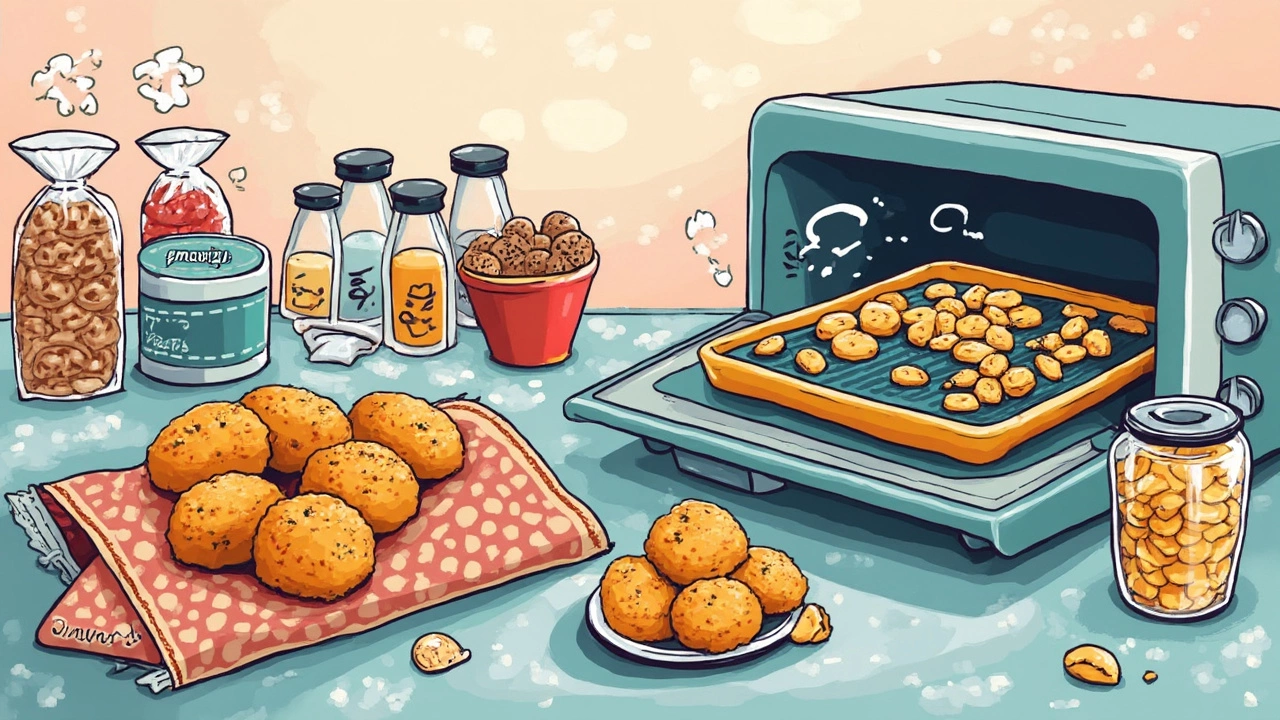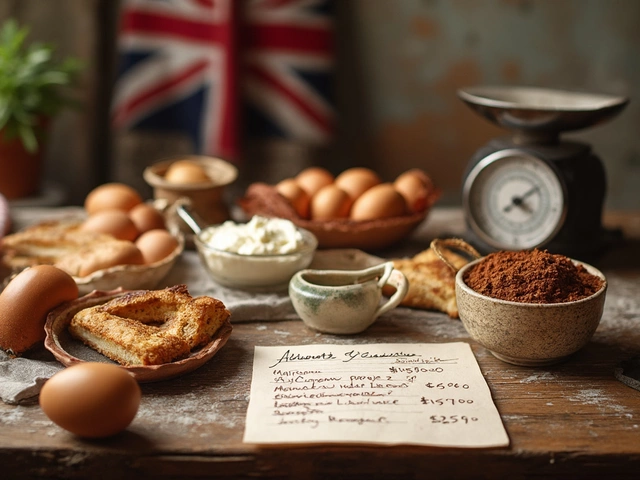
Ever pulled out a batch of snacks only to find they've turned limp before serving? It's frustrating. The problem usually starts either in the prep, or when they're left out just a bit too long. Air, moisture, and even the wrong type of storage can zap all the crunch out of your hard work.
If you bake or fry snacks like mini pastries or croquettes, keep them resting on a cooling rack—not straight onto a plate. You want air to circulate all around, otherwise steam gets trapped and softens everything. Another thing: never close the lid on the container while things are still warm. Trapped heat becomes trapped moisture, and that’s what really ruins the crispy magic.
If it’s tiramisu you're worried about (especially if you prep ahead for parties), there's a trick: only dunk the ladyfingers super quickly in coffee, just enough to wet the outside. Letting them soak turns them mushy, and that texture messes with the whole dessert. Got leftovers? Pop them in a loosely covered container in the fridge, but just know: even tiramisu has a best-before crunch time.
- Why Do Savory Snacks Go Soggy?
- Smart Prep: Secrets to Better Crunch
- Cooking Hacks for Long-Lasting Crispiness
- Storage Mistakes to Avoid
- Quick Fixes for Limp Snacks
- Crispy Tiramisu? Dessert Tips You Didn’t Expect
Why Do Savory Snacks Go Soggy?
We've all been there—savory snacks go from crispy to soggy in a flash. But what’s actually behind it? The main troublemaker is moisture. Once that gets in, your snacks don’t stand a chance. Hot snacks, like cheese puffs or croquettes, are at extra risk because of steam and condensation during and after cooking.
Here's the science part: when snacks cool, steam tries to escape. If snacks sit flat on a plate, that steam's got nowhere to go and turns right back into water, which the snack absorbs. That’s why things like empanadas or spring rolls lose their crunch so quickly.
Even air plays a role. Humid kitchens speed up sogginess, and storing snacks in airtight containers before they're fully cool traps every drop of leftover moisture.
Check out how these factors play out:
| Culprit | How It Happens | Effect |
|---|---|---|
| Steam | Rises from hot food and condenses on surfaces | Soggy exteriors, limp texture |
| Air | Humidity in the kitchen, damp storage places | Makes crisp snacks go soft |
| Wrong Container | Closed containers trap heat and moisture | Crunch turns to mush rapidly |
If you care about savory snacks staying lively, aim to control these moisture traps right from the start.
Smart Prep: Secrets to Better Crunch
The right prep makes or breaks your snack’s crunch factor. Before you even think about the oven or fryer, the basics matter—especially moisture. Too much liquid in your dough or batter? That’s a soggy snack waiting to happen. Use cold, dry ingredients and keep an eye on hydration. For stuffings or fillings, strain off any extra juices. Even shredding cheese and patting it dry with a paper towel can help.
If you’re coating snacks (think: breading for croquettes or kibes), do it in layers. Here’s a simple routine: dredge in flour, dip in beaten egg, then roll in breadcrumbs. Each step creates a barrier against steam sneaking in later. If you’re making things ahead, let prepped snacks chill in the fridge for at least 20 minutes before cooking—this step really helps crumbs stick and gives an even crunch.
- Always let dough relax before rolling out; this avoids overly dense or chewy crusts.
- For spring rolls or pastéis, dust a little cornstarch on the surface before frying; it grabs moisture and keeps the shell crispier.
- When prepping ladyfingers for tiramisu, use ones a bit stale or dry. They soak up coffee fast, but don’t get mushy.
One more pro move—slice or shape snacks the same size. Uniform pieces mean they cook at the same rate, so you don’t end up with half-burned, half-soggy results. And whatever you do, cook in small batches. Crowding your pan or baking tray makes steam build up and kills the crunch.
Dialing in these smart prep moves keeps your savory snacks light, crispy, and frustration-free.
Cooking Hacks for Long-Lasting Crispiness
If you want your savory snacks to keep their crunch, it all starts at the stove. Here’s what most home cooks miss: fat matters. Using the right oil makes a huge difference, and so does getting your frying or baking temp just right. Low heat equals soggy results, but too hot and you burn the outside while the inside stays raw.
- Savory snacks need oil heated to at least 170°C (338°F) for deep frying. A kitchen thermometer will save you from guesswork.
- When baking items like cheese puffs or empanadas, always preheat your oven—nothing kills crunch like starting cold. 200°C (390°F) is usually the sweet spot for even browning.
- Don’t overcrowd the pan or tray. Too many items at once drop the temp and cause steam buildup, and steam is the enemy of crispiness.
Tired of snacks getting soggy even after using the right oil? Try a double-cook technique. Fry or bake once, cool completely, then flash them again at the end for 2–3 minutes. This zaps leftover moisture and brings back crunch like magic.
Here’s a quick look at what really works (and what doesn’t):
| Method | Crispiness Score (1-5) | Best For |
|---|---|---|
| Single Fry/Bake | 3 | Quick results, but loses crunch fast |
| Double Fry/Bake | 5 | Snacks for later, batch parties |
| Low-Temp Cook | 1 | Not recommended, soggy every time |
A final tip: finish hot snacks with a wire rack. Never a plate, never a napkin. This trick, backed by commercial kitchens, keeps air moving and prevents steam from pooling underneath.

Storage Mistakes to Avoid
When it comes to keeping your savory snacks crispy, the wrong storage is usually where things fall apart. A lot of people just toss leftovers in whatever is handy, but not every container is created equal. Moisture and air are basically the enemy here. If you don’t keep these in check, even the crunchiest snack will turn soggy in no time.
- Never store hot snacks in a sealed container. Wait until they cool completely, or you’re just locking in steam and ruining your work.
- Don’t use plastic wrap right on top of the snacks. It traps moisture on the surface and makes everything soft.
- Placing snacks directly in the fridge can make things worse. Cold air makes condensation, especially if food is still a bit warm.
If you need to store them, use paper towels between layers to soak up excess moisture. Pick a container with a loose-fitting lid, or cover lightly with foil. For stuff like croquettes or cheese snacks, skip the fridge whenever you can—unless you really need to keep them overnight. If you’re dealing with tiramisu or anything with a creamy layer, storage does get tricky. The cream releases moisture that soaks into the biscuit layer over time. You can slow this with a quick assembly, waiting until just before serving to put it all together.
| Snack Type | Room Temp (Airtight) | Fridge (Airtight) |
|---|---|---|
| Cheese puffs | 2 days | 4 days |
| Mini empanadas | 1-2 days | 3 days |
| Tiramisu | Not recommended | 2 days |
The bottom line? For savory snacks, controlling moisture is everything. Avoid plastic wrap, let things cool off, and use a barrier like paper towels. That little bit of effort keeps snacks tasting fresh and keeps you from throwing out mushy leftovers.
Quick Fixes for Limp Snacks
Don’t toss those soggy snacks just yet. You’ve actually got a few tricks to bring back the crunch—no one needs to know they ever lost it. Most snacks, even pastries and chips, can bounce back with the right method.
- Oven Rescue: Spread your savory snacks out on a baking sheet, pop them in an oven preheated to 180°C (350°F), and let them heat for 3–7 minutes. Dry heat helps zap the extra moisture fast. Let them cool for a couple minutes; that’s when the crispiness sets.
- Air Fryer Blast: If you’ve got an air fryer, use it! Just a couple of minutes at 180°C (350°F) brings snacks like cheese pastries or even fries right back to life. Don’t pile them—give them space.
- Microwave—With Caution: For chips or crackers, put them on a microwave-safe plate lined with a paper towel and zap them for 30 seconds. Keep an eye on them to avoid burning, but microwaves can help when you’re in a hurry.
Professional chefs actually rely on these quick fixes more often than you’d think. As Mark Bittman says,
“Rescuing soggy snacks is all about dry heat and airflow. You can get back most of a snack’s original texture with a few minutes in the oven.”
If your snacks still seem off, add a sprinkle of salt or spices after re-crisping, which boosts flavor and absorbs any bits of leftover moisture.
Here’s a handy table showing which fix tends to work best for certain snacks:
| Snack Type | Best Method | Average Time |
|---|---|---|
| Croquettes, empanadas | Oven or air fryer | 5–7 min |
| Potato chips | Microwave or oven | 1–3 min |
| Mini cheese puffs | Oven | 3–5 min |
| Spring rolls | Air fryer | 3–4 min |
Don’t forget: after re-crisping, always let snacks cool on a rack to stop steam from undoing your hard work. Next time someone complains about limp snacks, you’ll be the hero.
Crispy Tiramisu? Dessert Tips You Didn’t Expect
Tiramisu isn’t exactly the first dessert you think of when you want crunch. But here’s the thing: you can keep some bite in the ladyfingers, even after soaking and chilling. The trick is all about speed and assembly.
First, give those ladyfingers the world’s quickest dunk—no more than a second on each side. You just want them barely coated with coffee, still firm on the inside. Too many people soak them until floppy, and that’s the fastest way to lose texture. If you use homemade ladyfingers with a bit more thickness, you’ve got even more wiggle room to avoid sogginess.
- Chill your tiramisu in the fridge with just a loose cover, never wrapped tight. This helps excess moisture escape instead of getting trapped in the dish.
- Layer mascarpone cream carefully so it just covers the biscuits, rather than flooding them. More cream means more moisture.
- Serve within six hours for best texture. That’s when you get a balance between creamy and ‘snappy’—not mushy.
Ever thought of making an individual tiramisu in a glass? The small portion keeps moisture more controlled, so your bottom layer doesn’t have time to go soft. If presentation matters, add a sprinkle of toasted nuts, cocoa nibs, or crushed cookies on top just before serving. It’s an instant boost of crunch, no fancy tools needed.
Here’s a quick comparison for how long tiramisu keeps its texture based on assembly and storage:
| Method | Texture After 3 hrs | Texture After 8 hrs | Texture After 24 hrs |
|---|---|---|---|
| Quick Dip, Loosely Covered | Moist with bite | Soft but not soggy | Fully soft, holds shape |
| Fully Soaked, Wrapped Tight | Soft | Mushy | Very mushy, falls apart |
Using these tricks, you don’t have to settle for spongy desserts. With a few adjustments, you keep that layer of ladyfingers a little more ‘savory snack’ and a lot less sponge. That’s how you make even savory snacks fans happy, right at dessert time.










Write a comment